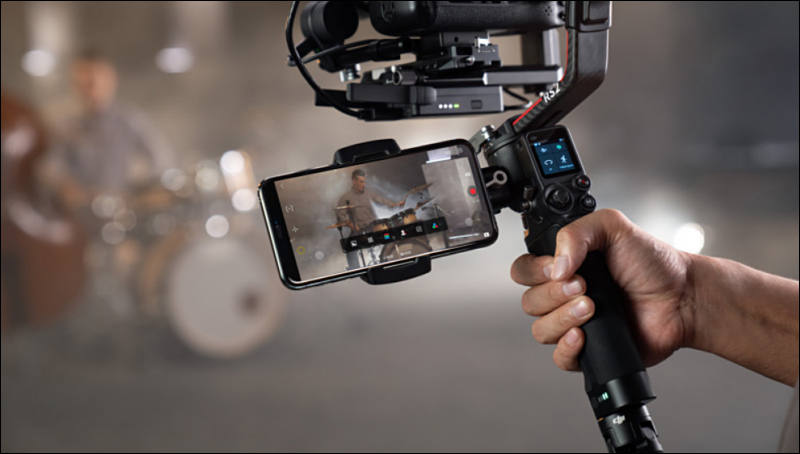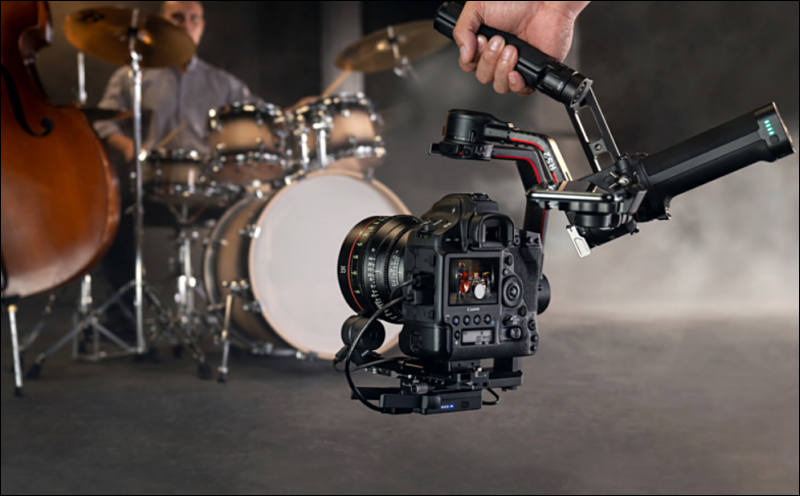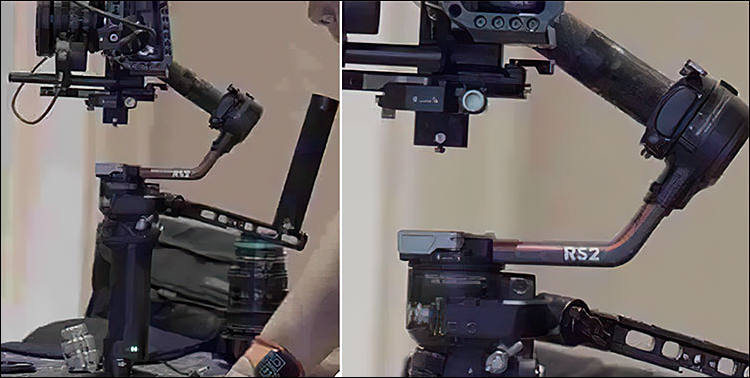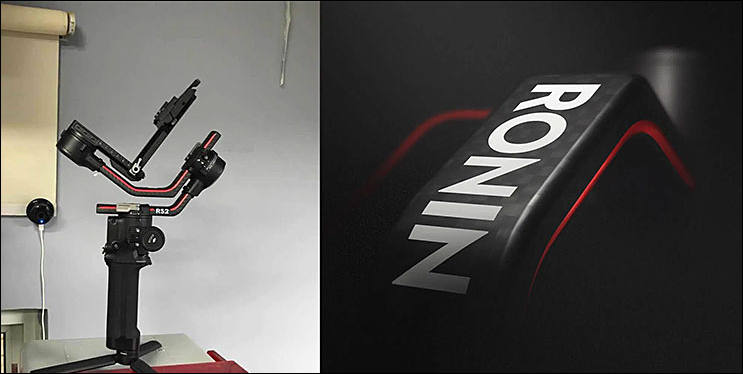
-

Advanced modes
- Time Tunnel: The system performs a 360-degree roll while capturing a hyperlapse
- Flashlight: The system tilts the camera all the way forward so you can grip the base like a flashlight
- One-Tap Portrait Mode: The gimbal quickly orients the camera into vertical shooting
- Panorama: After configuring sensor and focal length, choose a start and stop point for panoramas up to gigapixel size
- Roll 360: The gimbal enters into the Flashlight position and rolls the camera system 360 degrees
- Timelapse: This classic feature shows subtle changes over durations of your choosing

-


S2 Lite gimbal will be absolutely same but using different materials for some parts, and may be slightly weaker motors.

 sa14417.jpg750 x 378 - 47K
sa14417.jpg750 x 378 - 47K
 sa14418.jpg743 x 374 - 30K
sa14418.jpg743 x 374 - 30K -
So the s2 can carry as much as crane 3s ?
-
At DJI, our goal is always to bring products to the market that inspire creativity and push the industry forward. After careful consideration, we have decided to reschedule the September 9th announcement for a later date in October.
We ask you to stay tuned a little longer to see a lot more. The next generation of gimbal technology will now be unveiled next month, so we can present the world's creators with two incredible new options for capturing the world around you.
Rumors are that it can be related to manufacturer of all main DJI chips, and it is either SMIC that will full stop in coming months due to sanctions or TSMC (with HiSilicon helping design) and it already done stuff.
-
DJI, the global leader in civilian drones and creative camera technology, today expands the legacy of the highly popular and prestigious DJI Ronin series, by introducing the rebranded DJI RS 2 and DJI RSC 2. Redesigned and reimagined, both systems offer the filmmaking and content creation community an extremely robust, versatile, and professional 3-axis camera gimbal for their various needs. DJI RS 2 brings added strength and agility to creators using heavier camera systems such as DSLR and compact cinema cameras. At the same time, DJI RSC 2 was created to be more portable, meeting the needs of mirrorless and more compact camera operators.
"DJI's first Ronin-S and the original Ronin-SC created so much excitement when they launched that we immediately went back to the drawing board to figure out how to make our products even better," said Paul Pan, Senior Product Line Manager. "Just like with the first version, we took time to research how our professional customers use their Ronin products and what new features they wanted in the next generation of a handheld gimbal. Yet again, the result is the culmination of user feedback, years of design and development, and significant advancements in stabilization technology. Now we are excited to showcase two new filmmaking tools designed to meet the needs of a wide array of filmmakers. From cinema cameras to mirrorless systems, we have a solution for you."
DJI RS 2: Masterfully Crafted
Considering a tremendous amount of feedback from professional operators, DJI RS 2 incorporates carbon fiber in vital structural components, reducing weight down to 1.3 kg (2.86 lbs) while remaining highly durable. Pushing the innovation of single-handed gimbal technology even further, DJI RS 2 now supports a tested dynamic payload of 4.5 kg (10 lbs) for creators to use heavier camera and lens combinations while still achieving up to 12 hours of battery life. A new quick-charge function directly to the battery handle has been added for urgent situations, providing an extra two hours of battery life with just a 15-minute charge.
DJI RS 2 continues pushing gimbal technology forward with the ability to support heavier payloads while capturing ultra-smooth cinematic footage. Based on years of experience developing predictive technology, a newly optimized Titan Stabilization Algorithm reduces the need for manual user input while compensating for user movement and optimizing the gimbal tilt and angle. Additionally, a new SuperSmooth mode provides another level of camera stability, especially for compensating longer focal length lenses of up to 100mm.
Simple to set up, easy to operate, and highly customizable, DJI RS 2 was created to allow filmmakers to adapt their system to their filming needs while feeling confident it will easily integrate into their workflow. Axis locks enable easier transportation and balancing, while a dual-layer camera mounting plate is compatible with both the Arca-Swiss and Manfrotto standard. A fine-tune balancing knob allows for even more precise balancing of the camera payload. The built-in 1.4" color touchscreen can display camera data, gimbal settings, or a live feed from the camera. Supporting 11 different languages, the ultra-bright screen can also initiate key functions such as ActiveTrack and intelligent shooting modes. The built-in front dial above the trigger allows for precise focus control and complements a DJI Focus Wheel mounted on the RSA port to create two-channel focus and zoom.^[] ^DJI RS 2 also turns into a versatile tool that can be attached and used with other systems such as jibs, car attachments, and sliders. Two RSA ports double as NATO ports so that users can mount accessories and attachments such as grips and a remote controller.
DJI RSC 2: Filmmaking Unfolds
A completely new and portable folding design makes DJI RSC 2 easy for creators to carry everywhere without adding additional weight to the gear list. Additionally, the folding design provides creative ways to use the gimbal such as vertical filming without additional accessories, as well as a new Briefcase mode, where the main gimbal arm can be loosened and slung forward to provide unique shooting angles. Durable materials like steel are used on vital and frequently used components, while lightweight materials such as aluminum reduce overall weight. DJI RSC 2 weighs in at 1.2 kg (2.65 lbs), nearly 35% less than the original Ronin-S, and has a folding footprint of 180×190 mm, the same size as a sheet of A5 paper. The built-in battery offers an impressive 12 hours of battery life and -- like DJI RS 2 -- the new quick-charge function directly to the battery handle has been added for urgent situations.
DJI RSC 2 remains lightweight and portable, featuring stronger motors to support a tested payload of up to 3 kg (6.6 lbs). This increased dynamic payload supports popular mirrorless cameras along with heavier combinations like the Panasonic S1H and a 24-70mm lens. Using the same advanced technology as DJI RS 2, the newly optimized Titan Stabilization Algorithm generates a new level of stability -- smoothing out fine details in conjunction with the motorized gimbal for some of the most advanced stabilization on the market. DJI RSC 2 is compatible with a wide array of camera models so users can get the most out of the system. Axis locks enable easier transportation and balancing, while a dual-layer camera mounting plate is compatible with both the Arca-Swiss and Manfrotto standard. A 1" built-in OLED screen displays camera data with the ability to adjust settings directly.
Multifaceted Gimbals Supported by an Advanced App and Accessories
DJI RS 2 and RSC 2 were designed to expand beyond single-handed stabilization into tools that can be customized with additional accessories to achieve the desired shot. These accessories include a cheese plate, Focus Wheel, 3D Focus System, Twist Grip Dual Handle, RavenEye Image Transmission System, Tethered Control Handle, counterweight systems, and more.^[]^ For remote operation, both DJI RS 2 and DJI RSC 2 can use ActiveTrack 3.0 when the RavenEye Image Transmission System is connected, sending a 1080p/30fps low-latency feed to a mobile device using the Ronin app from up to 200 meters away.
Vital features and functions can now be controlled and adjusted over long distances with the Ronin app such as gimbal movement using the virtual joystick and Force Mobile, where the gimbal mimics the mobile device's movement. For solo operators using manual-focus lenses, the 3D Focus System uses state-of-the-art TOF sensors mounted above the camera to provide autofocus. This enables a single shooter to capture smooth and cinematic footage using a manual lens, without relying on a second camera operator or focus puller.
Pre-Programmed Movements and Features That Make Stories Come to Life
DJI RS 2 and RSC 2 expand on their predecessors' suite of creative modes, movements, and features with tools to help capture content that stands out, including:
- New Time Tunnel: The system performs a 360-degree roll while capturing a hyperlapse, adding a level of creativity to footage.
- Flashlight: The system tilts the camera all the way forward so users can grip the base like a flashlight.
- One-Tap Portrait Mode: The gimbal quickly orients the camera into vertical shooting for professional-level social media content.
- Panorama: After configuring sensor and focal length, choose a start and stop point for panoramas up to gigapixel size.
- Roll 360: The gimbal enters into the Flashlight position and rolls the camera system 360 degrees.
- Timelapse: This classic feature shows subtle changes over durations of your choosing.
DJI Care Refresh
DJI Care Refresh is now available for both DJI RSC 2 and RS 2. For an additional charge, DJI Care Refresh offers comprehensive coverage as well as up to two replacement units within one year. Receive your replacement even sooner with DJI Care Refresh Express. DJI Care Refresh also includes VIP after-sales support and free two-way shipping. For a full list of details, please visit https://www.dji.com/service/djicare-refresh.
Price and Availability
DJI RS 2 and DJI RS 2 are available for purchase today from authorized retailers and on www.store.dji.com. Each product offers purchase options for a standalone gimbal and a combination pack that includes additional accessories. The standalone DJI RS 2 is available for the retail price of $849 USD, and the standalone DJI RSC 2 is available at the retail price of $499 USD. The Pro Combo includes additional accessories such as a phone holder, Focus Motor, RavenEye Image Transmitter, dedicated carrying case, and more. The DJI RS 2 Pro Combo is priced at $999 USD, and the DJI RSC 2 Pro Combo is priced at $739 USD. Full details on this can be found below.
-
The TOF 3d focus module is very interesting, can something like this be integrated into a stand alone module with other follow focus systems to auto focus manual lenses ?
-
-
Tilta is making some pretty cool accessories. I always liked having the ring for my old Ronin-M...could never find a good one for the newer hand-helds. And the car mount? Cable cam? Steadycam sled? Oh my! https://tilta.com/2020/10/introducing-the-tilta-ecosystem-for-dji-rs2/
-
On autofocus
-
Ive got Rs2 combo recently. Very nice toy indeed.. However there are few limitations which is good to be aware of:
When using Raveneye with G9 (and probably all Panasonic) there is now preview on the camera screen so you still need to use phone. Which is unfortunate as little RS2 screen could do everything you need including drawing tracking target.
What ist worst when Raver is connected SR2 trigger does not work nor camera trigger so you may need phone for sure - not sure if it works (not tested as I would not use it anyway that way)
Focus wheel and focus half press does not work with manual focus settings on Z6 (its officially said by Dji but still sad)
There is preview and trigger working on Z6 as it should with Revan connected. Focus wheel works on G9 even in Manual mode and even focus half press in M if setup this way.
So it is nice tool but different benefits depends which camera you use... For Raven Z6 wins over Panas for Focus properly as well...
BTW: Could not find that info anywhere but for me was important: YES It can handle Z6 (in cage with handle) with Tamron 15-30 2.8 G2 on adapter (mounted on bigger Manfrotto plate to camera (not to adapter). So it is strong...
Cant test other cameras....
-
I'm also considering a gimbal for my GH4 with a possible upgrade to the GH5 or GH6? later this year. However I basically do ultra video angle most of the time, so I have the Olympus 7-14 PRO for photos - which is a heavy lens. (I also have the Pana 7-14 mm F4 but as I do mostly URBEX stuff i prefer the Oly PRO.) I wonder if the combination GH4/5 and the Oly 7-14 PRO can be accomodated on the DJI RSC2? They only mention the Pana 8-18 in the compatibility chart, but I rather try to avoid a new lens at the moment even if the 8-18 is tempting because of the flat front glass.
Anyone with a RSC2 and a heavy ultra wide angle lens?
-
@EspenB I dont have RSC2 so I cant tell. Ive got RS2 to be sure it will handle anything and for other benefits. Be aware Panasonics does not give you trigger and camera preview with Revaneye.
Howdy, Stranger!
It looks like you're new here. If you want to get involved, click one of these buttons!
Categories
- Topics List23,992
- Blog5,725
- General and News1,354
- Hacks and Patches1,153
- ↳ Top Settings33
- ↳ Beginners256
- ↳ Archives402
- ↳ Hacks News and Development56
- Cameras2,367
- ↳ Panasonic995
- ↳ Canon118
- ↳ Sony156
- ↳ Nikon96
- ↳ Pentax and Samsung70
- ↳ Olympus and Fujifilm101
- ↳ Compacts and Camcorders300
- ↳ Smartphones for video97
- ↳ Pro Video Cameras191
- ↳ BlackMagic and other raw cameras116
- Skill1,960
- ↳ Business and distribution66
- ↳ Preparation, scripts and legal38
- ↳ Art149
- ↳ Import, Convert, Exporting291
- ↳ Editors191
- ↳ Effects and stunts115
- ↳ Color grading197
- ↳ Sound and Music280
- ↳ Lighting96
- ↳ Software and storage tips266
- Gear5,420
- ↳ Filters, Adapters, Matte boxes344
- ↳ Lenses1,582
- ↳ Follow focus and gears93
- ↳ Sound499
- ↳ Lighting gear314
- ↳ Camera movement230
- ↳ Gimbals and copters302
- ↳ Rigs and related stuff273
- ↳ Power solutions83
- ↳ Monitors and viewfinders340
- ↳ Tripods and fluid heads139
- ↳ Storage286
- ↳ Computers and studio gear560
- ↳ VR and 3D248
- Showcase1,859
- Marketplace2,834
- Offtopic1,320






